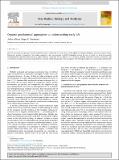| dc.contributor.author | Alleon, Julien | |
| dc.contributor.author | Summons, Roger E | |
| dc.date.accessioned | 2021-10-27T20:10:49Z | |
| dc.date.available | 2021-10-27T20:10:49Z | |
| dc.date.issued | 2019 | |
| dc.identifier.uri | https://hdl.handle.net/1721.1/135118 | |
| dc.description.abstract | © 2019 The Authors Here we discuss the early geological record of preserved organic carbon and the criteria that must be applied to distinguish biological from non-biological origins. Sedimentary graphite, irrespective of its isotopic composition, does not constitute a reliable biosignature because the rocks in which it is found are generally metamorphosed to the point where convincing signs of life have been erased. Rather, multiple lines of evidence, including sedimentary textures, microfossils, large accumulations of organic matter and isotopic data for co-existing carbon, nitrogen and sulfur are required before biological origin can be convincingly demonstrated. | |
| dc.language.iso | en | |
| dc.publisher | Elsevier BV | |
| dc.relation.isversionof | 10.1016/j.freeradbiomed.2019.03.005 | |
| dc.rights | Creative Commons Attribution-NonCommercial-NoDerivs License | |
| dc.rights.uri | http://creativecommons.org/licenses/by-nc-nd/4.0/ | |
| dc.source | Elsevier | |
| dc.title | Organic geochemical approaches to understanding early life | |
| dc.type | Article | |
| dc.contributor.department | Massachusetts Institute of Technology. Department of Earth, Atmospheric, and Planetary Sciences | |
| dc.relation.journal | Free Radical Biology and Medicine | |
| dc.eprint.version | Final published version | |
| dc.type.uri | http://purl.org/eprint/type/JournalArticle | |
| eprint.status | http://purl.org/eprint/status/PeerReviewed | |
| dc.date.updated | 2019-06-10T14:02:45Z | |
| dspace.orderedauthors | Alleon, J; Summons, RE | |
| dspace.date.submission | 2019-06-10T14:02:46Z | |
| mit.journal.volume | 140 | |
| mit.metadata.status | Authority Work and Publication Information Needed | |
